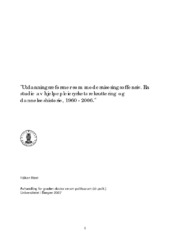| dc.description.abstract | The dissertation describes and analyses how central education reforms through a period ofmore than 40 years influences on a particular field of vocational education and work,auxiliary nursing. The reforms do not meet a field that is easily reconstructed through centralplanning and modernisation. The analytical perspective of the dissertation is to study howeducation reforms interact with other conditions contributing to the shaping of this field, asthe established recruitment patterns based on adult females, and the position the auxiliarynurses hold in the division of labour, as subordinated to the nurses.The study is based on empirical data from several research projects finished during the lastyears and which includes studies of education policy, collective organisation, students andrecruitment patterns. This includes interviews with representatives from the educationalauthorities, the health authorities, local administrators of both education and the care andnursing services, teachers, tutors, and students. It also includes document studies and a largesurvey of candidates from the auxiliary nurse education..The study also makes use ofeducation and personell statistics from public databases in order to establish time seriescovering a period of 40 years.The establishment of the auxiliary nurse education in 1963 symbolises a break in the way ofrecruiting, educating and organizing nursing personnel. Previously nursing had been dividedin two, with the registered nurses on the one side and the unskilled on the other. With theauxiliary nurse education a third way was introduced. The education was established underwhat is described as organized modernity. During this period mass education was organized,occupations were established also on the lower level, the females were entering the labourforce, hospitals and nursing homes were build, and new employee organisations werefounded. The belief in the rational governing of society through comprehensive stateinterventions were during this period probably stronger than ever. The establishment of theauxiliary nurse education was, however, not only a modernisation from above. It may partlybe seen as a modernisation from below in the sense that thousands of women pushed for theextension of the educational capasity in the field.The further efforts on modernizing the field through education reforms have a strongercharacter of modernisation from above. To an increasing degree they express the policy of modernizing the educational system; the needs to rationalize and unify educational paths,curriculas and search criterias. The aim was a more effective system giving the wholepopulation equal education offers independent of social class, geography and gender. Throughthese reforms the auxiliary nurse education is gradually closer integrated into the new uppersecondary school. From 1994 it is only offered as an education for adolescents, and the adulteducations are closed. However, quite a small number of adolescents opted for this kind ofeducation. The result was a great decrease in recruitment. The reform in 2000, the socalledcompetency reform, introduces a new scheme giving adults possibilities of going throughsocalled real competency assesments. This reform unintendedly reopened the traditionalrecruitment path into auxiliary nursing, attracting thousands of adult females.The most important finding of the dissertation is that there exists a very strong pattern ofrecruitment into the auxiliary nurse education and occupation among adult females which theeducational authorities, though trying hard, have not succeeded in changing througheducational reforms. Those applying for auxiliary nurse education today have importantsimilarities with the ones applying in the 1960’s. Most of them are adult females withexperience from unskilled care work and caring for their own children and families. Theaverage age of the candidates is 33 years. At the same time the applicants of today are moreeducated and have longer work experience. The education policy in this field, which still is torecruit adolescents through upper secondary school, must be characterised as a failure. Only asmall share of the recruitment, about 20 percent, comes from this group. The costs of thispolicy seems to be that the professionalisation of the field of work has been suffering. Byconcentrating on developing an education directed towards the ones who are not beingrecruited, the educational authorities have abdicated from the role as organizer of educationand learning to those who are doing the work and who want education, the adults. This groupis left to participate in fragmented, individualised learning scheemes, normally organised onan ad hoc-bases and in close connection to the work places. This may be seen as an exampleof the resolving of organized modernity with strong collective arrangements as standardisededucations and occupations. It is replaced by a modernity giving more space to individualsolutions, and where the steering capasity of the state is reduced. | en_US |
